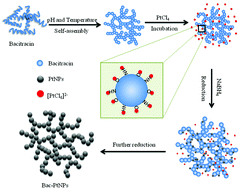Biologically inspired self-assembly of bacitracin-based platinum nanoparticles with anti-tumor effects
Abstract
In recent years, there has been increasing interest in fabricating noble metal nanoparticles using bio-templates for various biomedical applications, with the hope of finding a low cost method for their construction by a fairly simple and environmentally friendly synthetic strategy. In this study, novel self-assembled superstructures, namely, bacitracin–platinum nanoparticles (Bac–PtNPs), were designed and prepared under mild conditions. Bacitracin has two purposes: self-assembly to form a specific structure and the recognition of platinum nanoparticles, providing nucleation sites to form the nanomaterials. The spherical chain-like Bac–PtNPs were synthesized by the incubation of bacitracin and PtCl4 aqueous solutions at pH 2.0 for 24 h. The nanoparticles were face-centered cubic (fcc) crystalline, which were stable in aqueous solution. Functional groups such as –NH and –OH on the bacitracin surface serve as binding moieties and mediated the initial growth of the Pt nanoparticles. Anti-tumor effects exhibiting excellent therapeutic efficacy were confirmed both in vitro and in vivo. This study introduces a simple and effective platform for the design and preparation of the antitumor nanocomplexes, highlighting their potential applications in the biomedical field.



 Please wait while we load your content...
Please wait while we load your content...